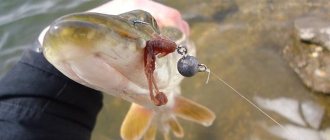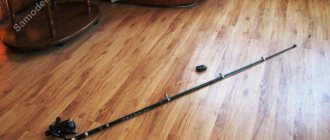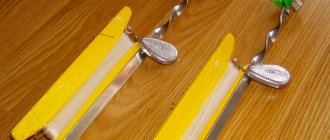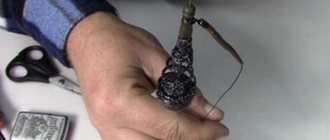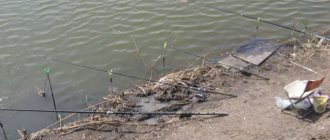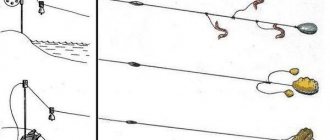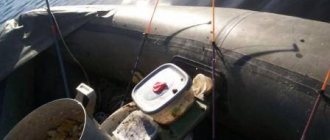Now in our country feeder fishing is becoming more and more popular. And all feeder lovers know how necessary leashes are in this matter. Of course, you can easily tie the leash on the spot, but take into account that the weather will be good.
What if there are competitions or rain with a cold wind? Of course, there is no time to knit this gear. This means only one thing, you need to have ready-made devices.
But an important item in this matter is the leash, which helps protect the leashes from mechanical stress and also prevents the gear from getting tangled.
Of course, you can purchase this device at a specialized store, but it will be cheaper to do everything yourself, given that it will take very little time.
So, from today’s article you will learn how to make a leash with your own hands.
Do-it-yourself leash holder - how to make it quickly and easily for a modern feeder (120 photos)
Now in our country feeder fishing is becoming more and more popular. And all feeder lovers know how necessary leashes are in this matter. Of course, you can easily tie the leash on the spot, but take into account that the weather will be good.
What if there are competitions or rain with a cold wind? Of course, there is no time to knit this gear. This means only one thing, you need to have ready-made devices.
But an important item in this matter is the leash, which helps protect the leashes from mechanical stress and also prevents the gear from getting tangled.
Of course, you can purchase this device at a specialized store, but it will be cheaper to do everything yourself, given that it will take very little time.
So, from today’s article you will learn how to make a leash with your own hands.
Brief contents of the review:
Tools for knitting leashes
The minimum set of tools for knitting leashes on hooks with a spatula looks like this.
1. Direct consumables: hook and leash line.
2. Crochet maker: a tool for holding a hook when tying a leash. This device is especially relevant when using small size hooks (from 20 to 18).
3. Loop knitting tool: a tool for knitting loops. There are different designs, including those with a scale for knitting loops of the same size or an extractor.
4. Scissors or wire cutters. This tool is needed to cut off the remaining line on the hook and loop. The main requirement is thin and sharp blades. By the way, scissors from manicure sets are very suitable for these purposes.
This set is also individual. You can safely knit hook and loops by hand, especially if you have experience or if you are using a hook with a ring. The tools are designed to make life easier for the fisherman, especially if a large number of leashes are knitted. But scissors are a tool you can’t do without. You need to cut the line carefully, leaving very short pieces - tails.
Insulation holder for pipes
As you can already understand, the first option will be made of polypropylene pipe. This method is not expensive at all, and production will take literally 15 minutes. The result is a simple leash for storing fishing leashes.
Let's start manufacturing.
Using scissors, we cut 2 pipes 35-40 cm long. And insert the one with a smaller diameter into the one with a larger one. In this way we compacted our base.
Now we take the pins and insert them on the side of our structure in a row. Choose the distance between them yourself, generally 1.5 cm is enough.
As you understand, the number of needles will mean the amount of space for leashes. If desired, you can make the length of the structure longer, so you will have more space for leashes. And so the leash holder, made with your own hands, is ready!
We also recommend that you label the places on the side so that you can be oriented by size and not have to look for the gear you need later.
For example, the most commonly used leashes range from 40 to 70 cm in length, so it is worth placing them in ascending order of length and hook number.
You see for yourself what gear you use and place them in the order that is convenient for you. By the way, you can also mark the length for yourself with the color of the pins, for example, red is 40 cm, blue is 50, etc.
Source
From quantity to quality
The feeder tackle is universal; it allows you to successfully catch both small and trophy fish. The approach to fishing, of course, is individual. This also applies to leashes. Roach, bream, sabrefish, crucian carp, carp... How many different leashes do you need to have in your leash for them? Leading lines of different diameters, hooks of different models and numbers. It’s very easy to get confused and knit leashes not systematically: what if these come in handy?
Over the past two seasons, I have come to a strong conclusion that a wide variety of hooks and leader lines not only complicates fishing, but also the process of preparing for it, the process of making leaders and storing them.
What this process looked like while fishing. Ah, I don’t like the implementation on a fishing line with a diameter of 0.14 mm. I'll take a leash with the same hook, but with a 0.12 mm fishing line. And so in a circle five times. You can go through the leashes endlessly, but time goes by...
What this process looked like during preparation. Finished line of leashes on 0.14 mm fishing line. Shouldn’t I also tie a line of leashes with the same hook, but with 0.16 mm fishing line, in case they come in handy?
The optimization process was quick and painless, and now you can share your experiences. Again, all this is individual and depends on the specific fishing conditions.
1. Using two leashes. One now stores leashes for catching crucian carp and crucian carp, the second - for roach, bream and saberfish. In a word, for all other types.
2. Diameter of the leader line. I refused to use fishing line with diameters up to 0.12 mm and over 0.20 mm. Such ranges cover all my needs and reduce the time for selecting the right leash.
3. Lead line manufacturer. Over two years of testing, I selected a fishing line that met several parameters: reliability, resistance to aggressive environments and fast fishing, an affordable price range and, which is also very important, constant availability for sale. This approach allowed us to reduce the number of repeated combinations of hook (model and number) and line (diameter).
3. Manufacturer of hooks. A large number of brands, names and models in stock always gives rise to experimentation and, as a result, clogs the leash with unnecessary and practically unused leashes. Also, experimentally, I chose for “work” two series of hooks for match and carp fishing from two manufacturers.
4. Hook size. How often in practice (not in sports) do you have to use hooks of 20, 18, 16 numbers? If only 16, and even then very rarely. In order not to get confused and not waste time trying to sort them out, it is better to exclude them. What's the point of feeding and waiting for a large river bream and waiting for it with a No. 18 hook on a 0.09 mm fishing line? 10, 12 and 14 are the most popular sizes, allowing you to cover maximum needs.
What do we get as a result? Take, for example, a size 10 hook. This is a really large hook made of fairly thick wire, necessary for catching strong river fish. If so, then it is better to tie such a leash on a 0.16mm fishing line. A size 12 hook of the same series (model) can be tied on a 0.14 mm fishing line, and a hook in size 14 can be tied on a 0.12 mm fishing line.
This results in three series of leaders for hooks of the same model. If we take into account that two models of hooks from different manufacturers were taken into “work”, there will be six series (or lines) of leashes in the leash.
DIY leash made from different materials
Fishing with float and feeder rigs is not complete without such an element of equipment as leashes, of which, for effective fishing, different quantities are required, both in the size of the hooks and in the length and diameters of the leash material itself. Fishing tactics include changing the element during periods of reduced biting activity to assemble thinner rigs, or vice versa, at a high fishing pace, replacing thin leash lines with thicker and coarser options, ensuring confidence in the reliability of all gear.
Tips for knitting leashes
Everything that makes the work of knitting leashes easier (hook knitting, loop knitting, scissors) has already been discussed many times. When knitting leashes, I also use a stationery pad - a sponge moistened with water. Having dipped your fingers into such a pad, it becomes more convenient to take a small hook and hold a thin fishing line.
Marking of leashes is also an important issue; it is undeservedly deprived of attention. To mark my leashes, I currently use multi-colored stickers - price tags for goods. They have an adhesive backing, which is very convenient, and are sold in all office supply stores.
These stickers cost about 30 rubles. I write information about the diameter of the fishing line and the hook model on the sticker with a bright black marker, and when gluing the sticker to the leader, I slightly reinforce the factory base with glue. The stickers stick firmly and are easy to replace.
Advantages of homemade products
A do-it-yourself leader not only saves the angler’s time while fishing by storing an arsenal of ready-made and assorted elements, but also allows you not to spend the family budget on purchasing a factory product, in principle, which is absolutely no different in functional features from homemade ones. In addition to these types of savings, when designing a device, you can take into account the nuances of the lengths of the driving elements and their quantity. And after updating, create a storage facility in which you can keep the leashes at their natural length, without worrying about possible tangling of materials and their deformation, as well as dividing the equipment element into certain categories to quickly find the size you need at the time of fishing.
Not the least advantage of homemade products is the choice of attractive cache materials, as well as its tuning, which can pleasantly please the angler’s eye for many fishing seasons, evoking positive emotions from the memories of past victories in anticipation of new and no less significant results.
Storing hooks and leashes
To store hooks and leashes, fishermen resort to various tricks:
- They use a regular photo album as a place to store attributes; the elements are placed in pockets, which are labeled (size, diameter).
- Along the entire length of the heat-insulating pipe, leashes with a loop are attached to the outside using a pin, and a hook is attached to the other side of the pipe. The disadvantage of this storage method is the unprotected structure and the possibility of damage during transportation.
- Popular devices for storing hooks with leashes are special plastic and wooden leash holders.
- Often, fishermen buy cheap foam reels.
It is best to store leashes with hooks, packaging them according to their characteristics, laying them out so that they do not become deformed. To avoid corrosion, a dry place is selected, and the paper in which it is better to wrap the elements is soaked in machine oil. Periodically, the hooks are lubricated with Vaseline.
Preparation of materials and tools
The preparation of the materials necessary to carry out the work will depend on what type of leash for the feeder you plan to make with your own hands. Indeed, in some cases, the basis of the product is a ready-made frame, which does not require any special transformations of the form, but requires only minor modifications. Options for producing fixtures from scratch will provide materials such as plywood, extruded polystyrene or plastic sheet.
Important! An indispensable element for performing work are pins.
Leashes for feeder
A wide variety of rigs for feeder fishing involves the use of different types of leashes. For their manufacture we use:
- leash line;
- fluorocarbon line;
- soft woven material;
- braided leash material.
The length of the feeder leash depends on:
- type of equipment used;
- the presence of deep silt in the reservoir;
- fish activity.
Each type of feeder equipment requires the use of hooks of a certain size and shape, as well as appropriate leader material. When fishing in reservoirs with deep silt, use a long leash made of monofilament fishing line; it is more catchy.
After casting, the feeder sinks into the silt, and the hook and bait remain on its surface and are accessible to fish. If aquatic inhabitants are inactive and reluctant to respond to bait, the tackle is made as long as possible, up to 1.5 m, so as not to frighten off the wary trophy.
A good leader material for a feeder should be:
- durable;
- abrasion-resistant;
- unnoticeable;
- durable.
The feeder method and the flat method are rigs that are used to catch solid trophies - carp, grass carp, and silver carp. On homemade gear, several leashes are sometimes tied on the main line, but such gear will not always be more catchy.
Required characteristics of leashes
The most important characteristics are:
- length of the leash for the feeder;
- hook shape and size;
- quality of the leash material.
Feeder leash length
Experts in feeder fishing recommend starting a session with classic rigs with leashes of 15-20 cm and lengthening them as necessary. The length of the feeder tackle affects the reliability of catching fish and the safety of landing it.
The longer the leash, the more inconvenient it is to control the tackle, so there must be reasonable balance. With frequent idle bites, you should, on the contrary, shorten the length on the feeder equipment until it begins to reliably detect the fish.
Leash length for feeder on current
When fishing with a feeder in the current, use heavy feeders and sticky bait. Method feeder equipment, as well as self-cutting classic installations, show high efficiency.
The length for flowing monofilament line is 30−100 cm, using hooks of numbers 14−18 according to the European classification. The fluorocarbon leash is stiffer, but less noticeable, so it is made shorter by 5-10 cm.
How to make a leash for a feeder
The leash for the feeder can be made in several types. The most common shapes are rectangular structures, similar to small boxes in height, devices in the form of a cylinder and book leashes. The finished product must meet a number of important requirements and, above all, be compact, lightweight, impact-resistant, durable and preferably waterproof. Having decided on the functionality of the device necessary for the fisherman, they make sketches of the future homemade product and acquire the materials and tools necessary to carry out the work.
DIY leash
A leash is a must-have for every fisherman. This accessory allows you to comfortably transport and use leashes when fishing with a feeder or float rod without much effort. It is very important to choose universal leashes, since leashes have different lengths. You can buy it at a fishing store or at the market, but it is much more convenient if a hand-made leash will provide you with comfortable fishing.
The accessory can be made from available materials, so you don’t have to spend a lot of money on purchasing components. Leaders made from cylindrical packaging, iron pipe, paint roller, cork, foam rubber, book or notepad, and wood are very popular among fishermen.
Branded
Rig Box from Guru
European manufacturers of equipment for feeder fishing such as Korum, Guru or Preston offer interesting and compact leashes that successfully perform their functions.
The Rig Box feeder holder from Guru is a lightweight plastic box that holds ten spools made of porous EVA material.
Leads with certain characteristics are wound on each spool, or rather:
- diameter of the leader line;
- leash length;
- hook number.
It is possible to wind 10–20 leashes on one spool, with each subsequent one hooked to the loop of the previous one. Thus, any leash is in a taut state, the fishing line is not deformed during transportation, and they are ready for use.
The presence of ten spools allows you to knit leashes with different characteristics and quickly change them.
Each spool is marked, where the angler indicates the characteristics of the leashes, so as not to get confused when fishing.
If you know exactly which leashes you will be fishing with, then you won’t have to take a leash with you when fishing, because one spool with the appropriate leashes is enough.
Considering that you have to fish with a feeder in difficult conditions, when every extra element of equipment only gets in the way, the Rig Box is very beneficial.
Boxed products
Guru and Korum also offer box-type leashes in which the hooks are attached to special crossbars, and the loops of the leashes are fixed with pins.
Such accessories are made of plastic, and the pins are stuck into the EVA material that covers the side surfaces.
Plastic leash holders are spacious and allow you to attach leashes up to a meter or more in length, and this length is in demand in feeder fishing.
There are already domestic analogues of similar leashes on the market, and Chinese manufacturers also offer exact copies of products from European companies.
Store-bought leashes are good for everyone, except for the price, and if you consider that it is better to have several of them, it is clear that material costs will be higher.
From cylindrical packaging
This is one of the simplest manufacturing options. A DIY leash from a cylindrical package turns out to be quite convenient and cheap. To make it, you will need to purchase packaging or goods in it. Many people use a packet of Pringles chips. You will not need special knowledge and skills, and the manufacturing process itself will not take much time.
Light weight and ease of use are considered significant advantages. Of course, the appearance of such a leash is not as presentable as that of purchased options, but we are going fishing, not to an exhibition.
Materials required for production
:
Manufacturing
From an iron pipe
You will need an iron pipe with a diameter of about 5 centimeters. For convenience, it is better to take a length of 30 centimeters. Now simply cover the pipe with foam. The pins for attaching the loops can be made from ordinary sewing pins.
Some fishermen also make plugs on the edges of the tube and then the leader with their own hands also becomes a tube for floats.
The disadvantages of such a leash include damage to the mounting foam due to physical contact with metal objects and periodic loss of needles. But, it will take you about 15 minutes to make such a practical leash, so you can eventually replace it with a new one.
This DIY feeder holder will be an excellent tool for fishermen. It copes with its functions remarkably well and is convenient to remove leashes from, although it is a bit heavy.
My leashes
It’s hard to believe it now, but my first leash was a twenty-page photo album. The pocket-like compartments for photographs ideally corresponded to my then ideas about a proper and functional leash. The tied leash was stored in such a pocket without creases and could be of any length; it did not need to be secured anywhere.
On the pocket itself, with a waterproof marker, a note was made about the length of the leash, the diameter of the fishing line, the name and number of the hook. The number of leashes constantly increased, and soon the pages in the photo album turned out to be insufficient.
And I switched to plastic fishing reels. On one reel, depending on its type, up to four leashes could be placed. I specifically bought reels of the same shape and size in the store to be sure of the same leash length.
Using the same marker on the reel, working marks were made on the length and type of materials used in the manufacture of the leash. All four leashes on one reel were tied on a fishing line of the same diameter and with the same hooks, this greatly simplified the use of leashes.
Over time, the number of reels with leashes has increased greatly, and this method of storing leashes has become extremely inconvenient. I brought a lot with me, how can I quickly find what I need among so many?
For the longest time I used a piece of heat-insulating tube as a leash. This option attracted me due to its cheap material, ease of manufacture and ease of use. The loop of the leash was attached to the head of a safety pin, and the hook was stuck into the body of the tube.
On average, 20 leads fit on one tube, which made it possible to have a large supply of leads with a smaller storage volume. The tube was also convenient because you could put it on the leg of the fishing platform and be sure that it would always be at hand.
From a notepad or book
You will need to tear out all the leaves from the book or notebook, leaving only the hardcover. Thus, so that you get a kind of little case. The size of the future leash will depend on the size of the notepad or book.
First you need to glue the fastener to the inside of the solid base. That's all. Now you have an excellent, comfortable and practical leash. With the right approach and careful handling, it will serve you for many years.
How to store a spinning rod, reel and leashes
Sports fishing tackle designed for catching predatory fish has a special structure and the interaction of all its component parts. Therefore, its functionality directly depends on the storage conditions of the spinning rod.
Made of wood
You can also make a leash from wood. A homemade wooden leash is universal and perfect for feeder leashes. But, you need to have at least some skills in working with wood. Although the process is quite complicated, it can serve you for decades.
First you need to find out what size jig is best for your fishing. The convenience of such a product is that you can choose your own options for transporting leashes - some prefer to transport them in a bent state, and others without deforming them.
You have to meet fishermen with meter-long wooden leashes, but this is rare.
The first step is to prepare the sashes. To do this, cut two boards to the desired size and sand them thoroughly. Thicker is more reliable, but along with the thickness of the boards, the weight of the finished product also increases.
The next step is making the sides. You will need to make 4 long and 4 short porticoes, which are joined together and sanded. The easiest way is to simply glue the wooden pieces together. You should end up with some kind of box. Inside this box you need to secure 4 strips with nails, which must not be driven in completely.
To avoid damage to the leads, cover the nails with rubber cambrics.
After adjusting and connecting the sides, you need to attach the hinges. In order for the leash to last longer and look more presentable, it can be varnished. For convenience and visibility of leashes, the product is painted inside with dark paint.
The leash often comes into contact with water and is located next to damp ground. Therefore, in order to increase its service life, it must be carefully varnished.
Locks, handles and corners are optional elements, so each fisherman decides for himself whether to attach them or not.
This DIY leash will serve you for a long time, will be durable and comfortable. True, if you compare it with analogues, it is much heavier. And such an accessory will take up too much space in your bag, which is quite inconvenient.
Source
Line leashes. What, why and where.
Professional fishermen spend a lot of time preparing for competitions. A three to four hour stay on a pond is followed by days of homework. Assembling gear, choosing bait, making equipment. But for amateurs there is no need to approach this matter so scrupulously. The main thing is to understand the general principles and apply them in practice. In this article I will talk about line leashes used in float and feeder fishing. Where and what to use, how to prepare and what to store.
What is a leash for?
Any novice angler will answer this question. The leash sacrifices itself in the event of a snag or excessive load, preserving the main equipment. Therefore, its diameter should be 0.02-0.03 mm less than the diameter of the main line. At the same time, the leash allows you to quickly change hooks if necessary. The connection itself with the main line is made loop-to-loop and can be easily separated if necessary (I add a small swivel between the loops, which prevents the line from twisting). This means you can quickly install a leash with a larger or smaller hook, with a hook of a different shape or with a different length and diameter of fishing line.
The need to change the hook is determined by the activity of the fish. Sometimes a smaller hook significantly improves the bite, but you should always correlate the diameter of the leader with the size of the hook. There is no point in tying a small bleak hook on a 0.18 mm fishing line or a No. 8 hook on a 0.08 fishing line. Here it is better to adhere to the principle of reasonableness. The leader test should approximately correspond to the hook extension force.
This is true for open water fishing, but I also use leaders in the winter. I have a braided thread wound on the reel of my fishing rod. It has zero stretch and transfers bites well to the hand. This property helps me when fishing, but not always when fishing. The cord can easily get tangled and can seriously cut your hands, especially if you catch a large fish. Therefore, in front of the bait I place a one and a half meter fluorocarbon leader with a diameter of 0.35-0.4 mm. When playing, as soon as the leash appears from the hole, it is convenient for me to intercept it with my bare hand and complete the fight with minimal effort. Another advantage of flurik is that, unlike wattle fence, it is transparent and less noticeable to fish. And when fishing with gliding baits, when it is necessary to slow down the fall of the spoon, such a thick leash plays the role of a parachute, placing the spoon in a horizontal position.
You can tie fluorocarbon and braided line together using the Albright knot.
I make 10-15 turns of the cord and tighten it, after wetting it. The protruding ends can be bitten off right at the root. The knot turns out durable and compact. And it’s easier for a small knot to slip through the rings and nod of a winter fishing rod.
Leash length.
If we are fishing with a float and the sinker lies on the bottom, then the longer the leash, the later we will feel the bite (this also applies to fishing with a feeder). But the fish, accordingly, later feels resistance from the sinker or float. It turns out that we are not observing a bite as such, but the movement of a fish with a hook that has already been swallowed. In case of fishing with a sensitive alarm (ultra-light floats, soft feeder tips), you must use a short leash of 10-15 cm, which transmits touches to the nozzle well.
We draw the following conclusion: if a bite is visible, but the fish is not hooked, then a long leash will help out; the bite is not visible, but the worm on the hook is eaten away - the leash is short.
How to make a leash with your own hands
An indispensable attribute of a fisherman is the presence of a leash, which performs the functions of storing and transporting pre-prepared leashes. Given the varied lengths of fishing products, it is necessary to take care in advance of a universal device that can conveniently accommodate any type of fishing line.
The main advantages of the leash include:
Manufacturers produce various types of leashes, which enable each fisherman to choose the most suitable option. However, most fishing enthusiasts prefer to make an accessory with their own hands from scrap materials. The most popular homemade products are presented below.
Wooden leash
The first step is to prepare the necessary materials, which you cannot do without during the manufacturing process, namely:
Step by step guide
Despite the rather labor-intensive process, the leash is as durable as possible and can serve its owner for many years. However, a small drawback is the weight of such an accessory and its large size. Such storage for leashes takes up a lot of space in a fishing backpack.
